Smooth Switching Technique for Voltage Balance Management Based on Three-Level Neutral Point Clamped Cascaded Rectifier
Abstract
:1. Introduction
2. Configuration and Control of Three-Level Neutral Point Clamped Cascaded Rectifier
2.1. Configuration and Control of Three-Level Neutral Point Clamped Cascaded Rectifier
2.2. Neutral Point Voltage Fluctuation Control of 3LNPC
3. Proposed Smooth Switching Technique
3.1. Analysis of the Voltage Balance
- (a)
- Switch State I: The switches S1, S2, S7 and S8 are on, while S3, S4, S5 and S6 are off. The output voltage is Vdc. C1 and C2 are charged when is > 0, and C1 and C2 are discharged when is < 0.
- (b)
- Switch State II: The switches S1, S2, S6 and S7 are on, while S3, S4, S5 and S8 are off. The output voltage is Vdc/2. C1 is charged when is > 0, and C1 is discharged when is < 0.
- (c)
- Switch State III: The switches S2, S3, S7 and S8 are on, while S1, S4, S5 and S6 are off. The output voltage is Vdc/2. C2 is charged in when is > 0, and C2 is discharged when is < 0.
- (d)
- Switch State IV: The switches S2, S3, S6 and S7 are on, while S1, S4, S5 and S8 are off. The output voltage is 0. The source has no effect on C1 or C2.
- (e)
- Switch State V: The switches S1, S2, S5 and S6 are on, while S3, S4, S7 and S8 are off. The output voltage is 0. The source has no effect on C1 or C2.
- (f)
- Switch State VI: The switches S3, S4, S7 and S8 are on, while S1, S2, S5 and S6 are off. The output voltage is 0. The source has no effect on C1 or C2.
- (g)
- Switch State VII: The switches S3, S4, S6 and S7 are on, while S1, S2, S5 and S8 are off. The output voltage is −Vdc/2. C2 is discharged when is > 0, and C2 is charged when is < 0.
- (h)
- Switch State VIII: The switches S2, S3, S5 and S6 are on, while S1, S4, S7 and S8 are off. The output voltage is −Vdc/2. C1 is discharged when is > 0, and C1 is charged when is < 0.
- (i)
- Switch State IX: The switches S3, S4, S5 and S6 are on, while S1, S2, S7 and S8 are off. The output voltage is −Vdc. C1 and C2 are charged reversely when is > 0, and C1 and C2 are when is > 0.
3.2. Switching Technique
3.3. Smooth Switching Technique
4. Voltage Balance Ability Calculation
5. Experimental Section
6. Conclusions
Acknowledgments
Author Contributions
Conflicts of Interest
References
- Peng, H.; Hagiwara, M.; Akagi, H. Modeling and analysis of switching-ripple voltage on the DC Link between a diode rectifier and a modular multilevel cascade inverter (MMCI). IEEE Trans. Power Electron. 2013, 28, 75–84. [Google Scholar] [CrossRef]
- McGrath, B.P.; Holmes, D.G. Multicarrier PWM strategies for multilevel inverters. IEEE Trans. Ind. Electron. 2002, 49, 858–867. [Google Scholar] [CrossRef]
- Kouro, S.; Malinowski, M.; Gopakumar, K.; Pou, J.; Franquelo, L.G.; Wu, B.; Rodriguez, J.; Perez, M.A.; Leon, J.I. Recent advances and industrial applications of multilevel converters. IEEE Trans. Ind. Electron. 2010, 57, 2553–2580. [Google Scholar] [CrossRef]
- He, X.; Shu, Z.; Peng, X.; Zhou, Q.; Zhou, Y.; Zhou, Q.; Gao, S. Advanced cophase traction power supply system based on three-phase to single-phase converter. IEEE Trans. Power Electron. 2014, 29, 5323–5333. [Google Scholar] [CrossRef]
- Zhao, C.; Dujic, D.; Mester, A.; Steinke, J.K.; Weiss, M.; Lewdeni-Schmid, S.; Chaudhuri, T.; Stefanutti, P. Power electronic traction transformer-medium voltage prototype. IEEE Trans. Ind. Electron. 2014, 61, 3257–3268. [Google Scholar] [CrossRef]
- She, X.; Huang, A.Q. Current sensorless power balance strategy for DC/DC converters in a cascaded multilevel converter based solid state transformer. IEEE Trans. Ind. Electron. 2014, 29, 17–22. [Google Scholar] [CrossRef]
- He, X.Q.; Guo, A.P.; Peng, X.; Zhou, Y.Y.; Shi, Z.H.; Shu, Z.L. A traction three-phase to single-phase cascade converter substation in an advanced traction power supply system. Energies 2015, 8, 9915–9929. [Google Scholar] [CrossRef]
- Vahedi, H.; Al-Haddad, K. A novel multilevel multi-output bidirectional active buck PFC rectifier. IEEE Trans. Ind. Electron. 2016, 63, 5442–5450. [Google Scholar] [CrossRef]
- Vahedi, H.; Philippe-Alexandre, L.; Al-Haddad, K. Balancing three-level NPC inverter DC bus using closed-loop SVM: Real time implementation and investigation. IET Power Electron. 2016, 9, 2076–2084. [Google Scholar] [CrossRef]
- Zou, R. Simulation study on transient current control of four quadrant converter. Electr. Drive Locomot. 2003, 6, 17–20. [Google Scholar]
- Shu, Z.; Zhu, H.; He, X.; Ding, N.; Jing, Y. One-inductor-based auxiliary circuit for DC-link capacitor voltage equalisation of diode-clamped multilevel converter. IET Power Electron. 2013, 6, 1339–1349. [Google Scholar] [CrossRef]
- Zhu, H.; Shu, Z.; Gao, F.; Qin, B.; Gao, S. Five-level diode-clamped active power filter using voltage space vector-based indirect current and predictive harmonic control. IET Power Electron. 2014, 7, 713–723. [Google Scholar] [CrossRef]
- Tallam, R.M.; Rajendra, N.; Nondahl, T.A. A carrier-based PWM scheme for neutral-point voltage balancing in three-level inverters. IEEE Trans. Ind. Appl. 2005, 41, 1734–1743. [Google Scholar] [CrossRef]
- Cobreces, S.; Bordonau, J.; Salaet, J.; Bueno, E.J.; Rodriguez, F.J. Exact linearization nonlinear neutral-point voltage control for single-phase three-level NPC converters. IEEE Trans. Power Electron. 2009, 24, 2357–2362. [Google Scholar] [CrossRef] [Green Version]
- Shu, Z.; Ding, N.; Chen, J.; Zhu, H.; He, X. Multilevel SVPWM with DC-Link capacitor voltage balancing control for diode-clamped multilevel converter based STATCOM. IEEE Trans. Ind. Electron. 2013, 60, 1884–1896. [Google Scholar] [CrossRef]
- Dujic, D.; Zhao, C.; Mester, A.; Steinke, J.K.; Weiss, M.; Lewdeni-Schmid, S.; Chaudhuri, T.; Stefanutti, P. Power electronic traction transformer-low voltage prototype. IEEE Trans. Power Electron. 2013, 28, 5522–5534. [Google Scholar] [CrossRef]
- Dell’Aquila, A.; Liserre, M.; Monopoli, V.G.; Rotondo, P. Overview of PI-based solutions for the control of DC buses of a single-phase H-bridge multilevel active rectifier. IEEE Trans. Ind. Appl. 2008, 44, 857–866. [Google Scholar] [CrossRef]
- Zhao, T.; Wang, G.; Bhattacharya, S.; Huang, A.Q. Voltage and power balance control for a cascaded H-bridge converter-based solid-state transformer. IEEE Trans. Power Electron. 2013, 28, 1523–1532. [Google Scholar] [CrossRef]
- Iman-Eini, H.; Schanen, J.L.; Farhangi, S.; Roudet, J. A modular strategy for control and voltage balancing of cascaded H-bridge rectifiers. IEEE Trans. Power Electron. 2008, 23, 2428–2442. [Google Scholar] [CrossRef]
- Moosavi, M.; Farivar, G.; Iman-Eini, H.; Shekarabi, S.M. A voltage balancing strategy with extended operating region for cascaded-bridge converters. IEEE Trans. on Power. Electron. 2014, 29, 5044–5053. [Google Scholar] [CrossRef]
- She, X.; Huang, A.Q.; Wang, G. 3-D space modulation with voltage balancing capability for a cascaded seven-level converter in a solid-state transformer. IEEE Trans. Power Electron. 2011, 26, 3778–3789. [Google Scholar] [CrossRef]
- Vazquez, S.; Leon, J.I.; Franquelo, L.G.; Padilla, J.J.; Carrasco, J.M. DC-voltage-ratio control strategy for multilevel cascaded converters fed with a single DC source. IEEE Trans. Ind. Electron. 2009, 3, 2513–2521. [Google Scholar] [CrossRef]
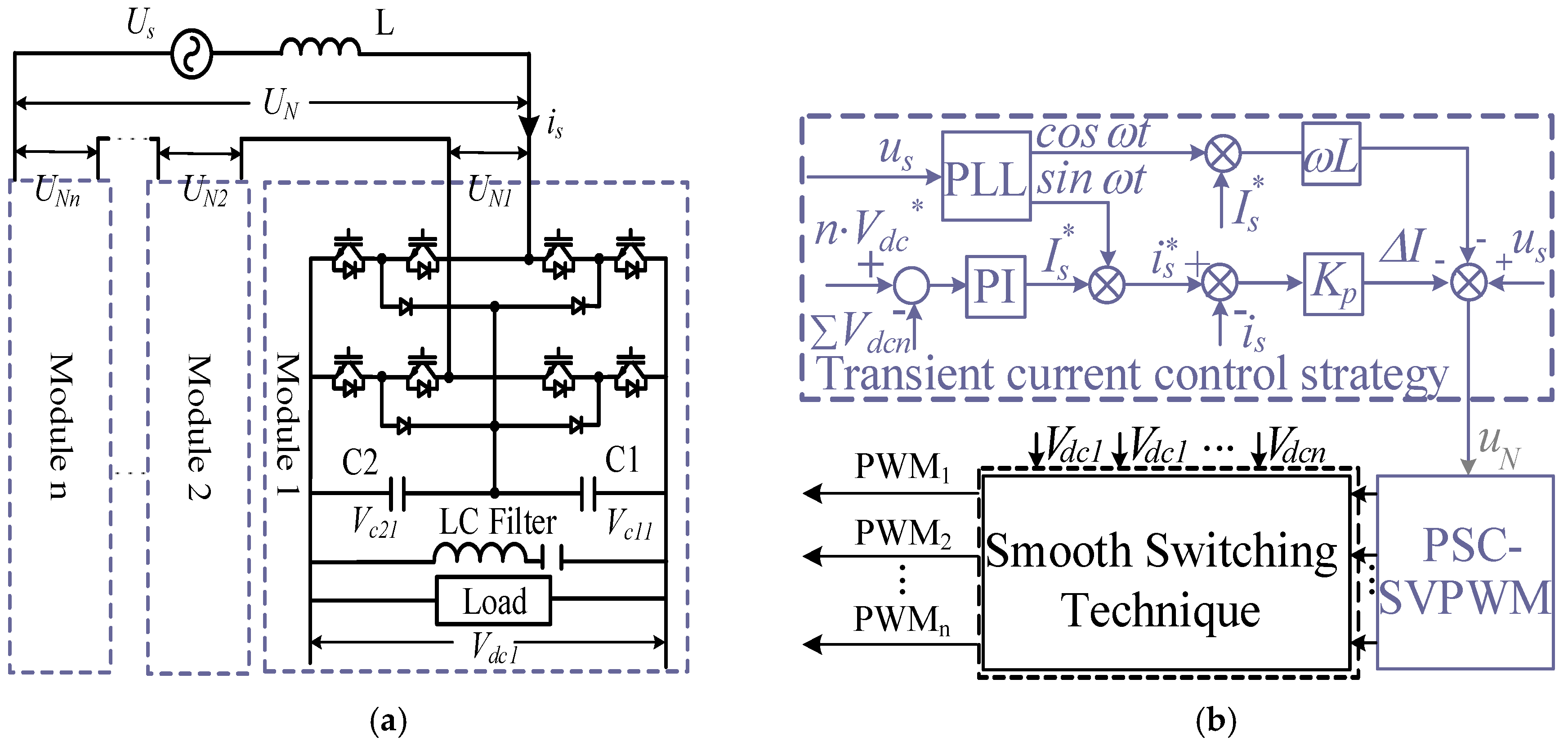
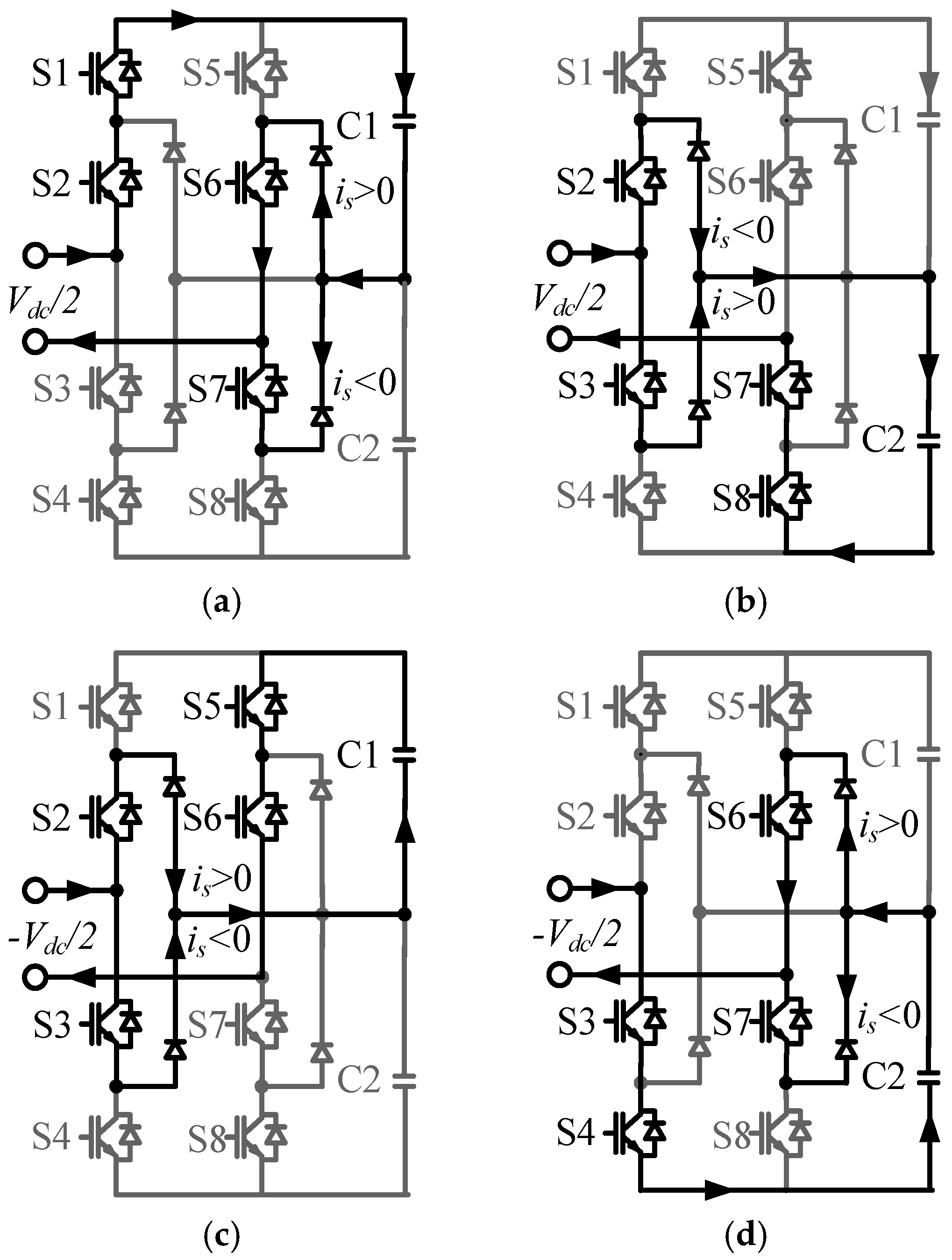
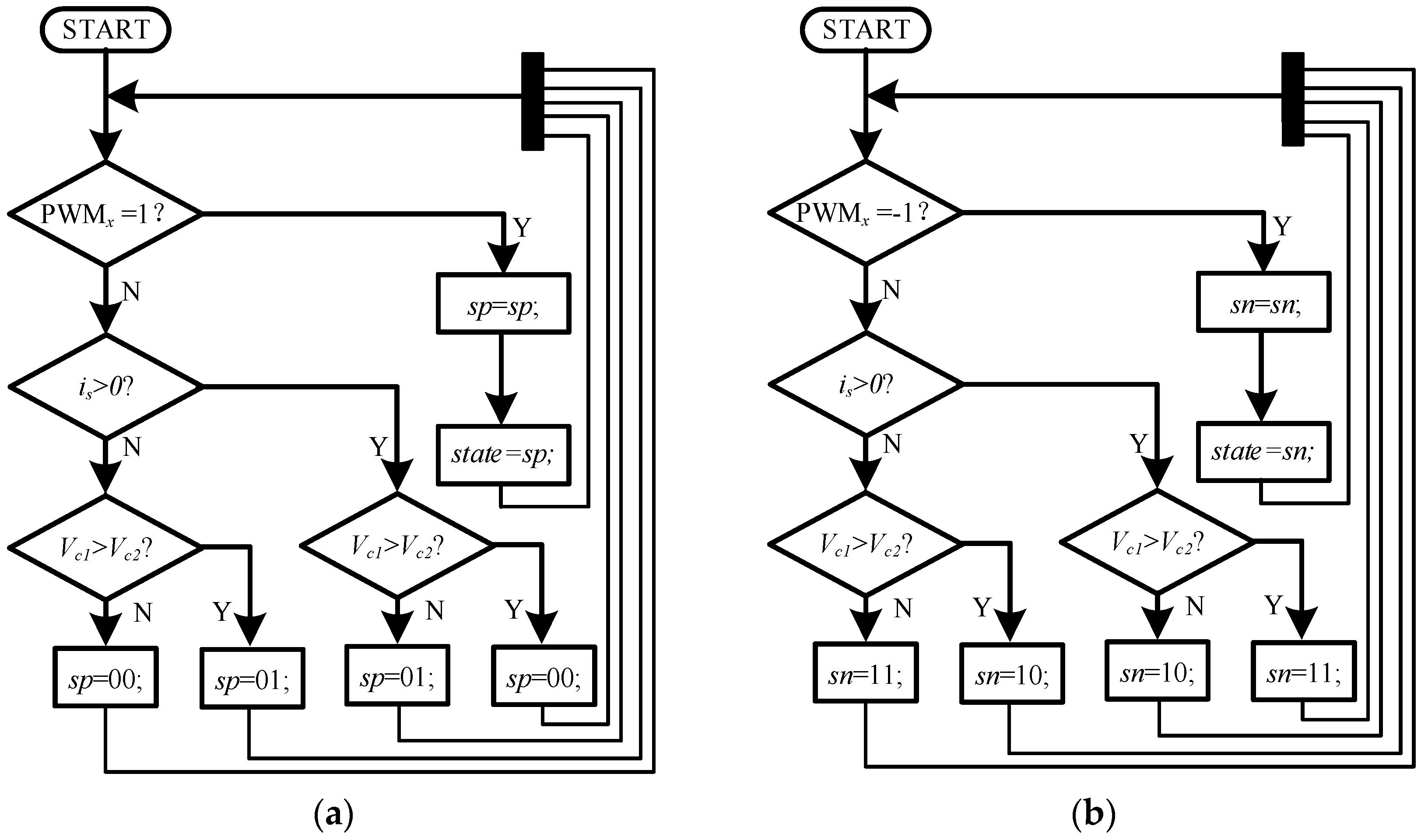
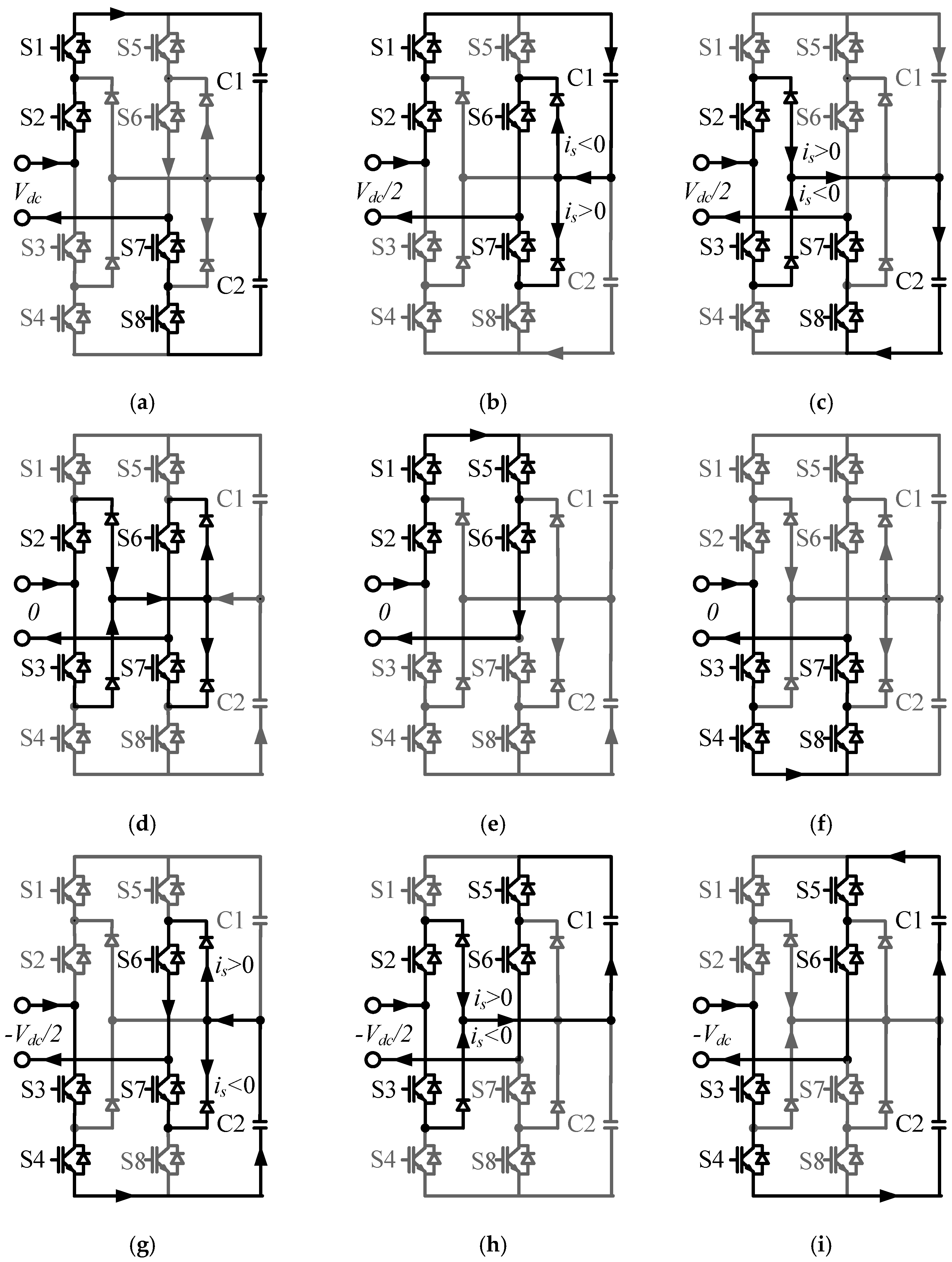
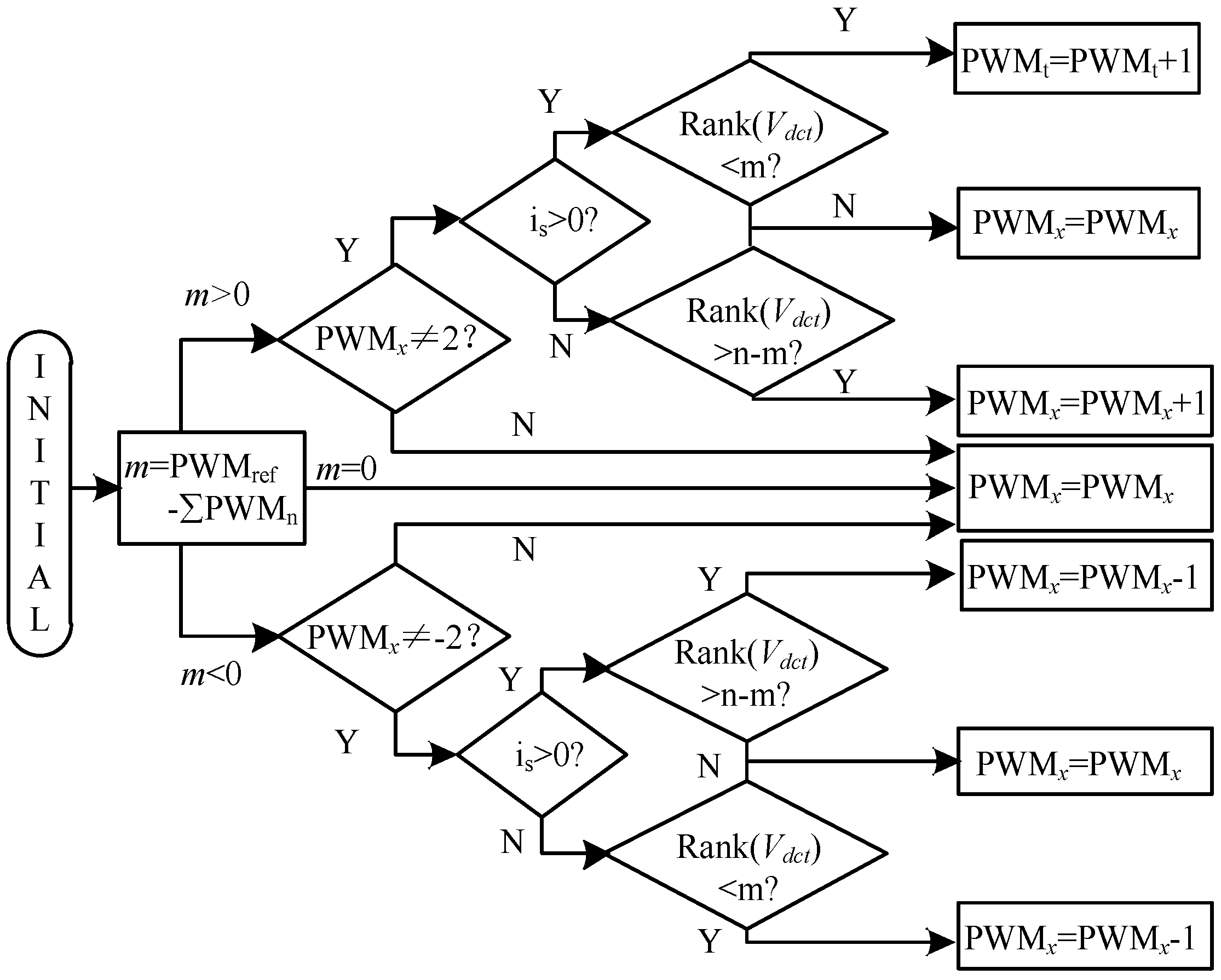
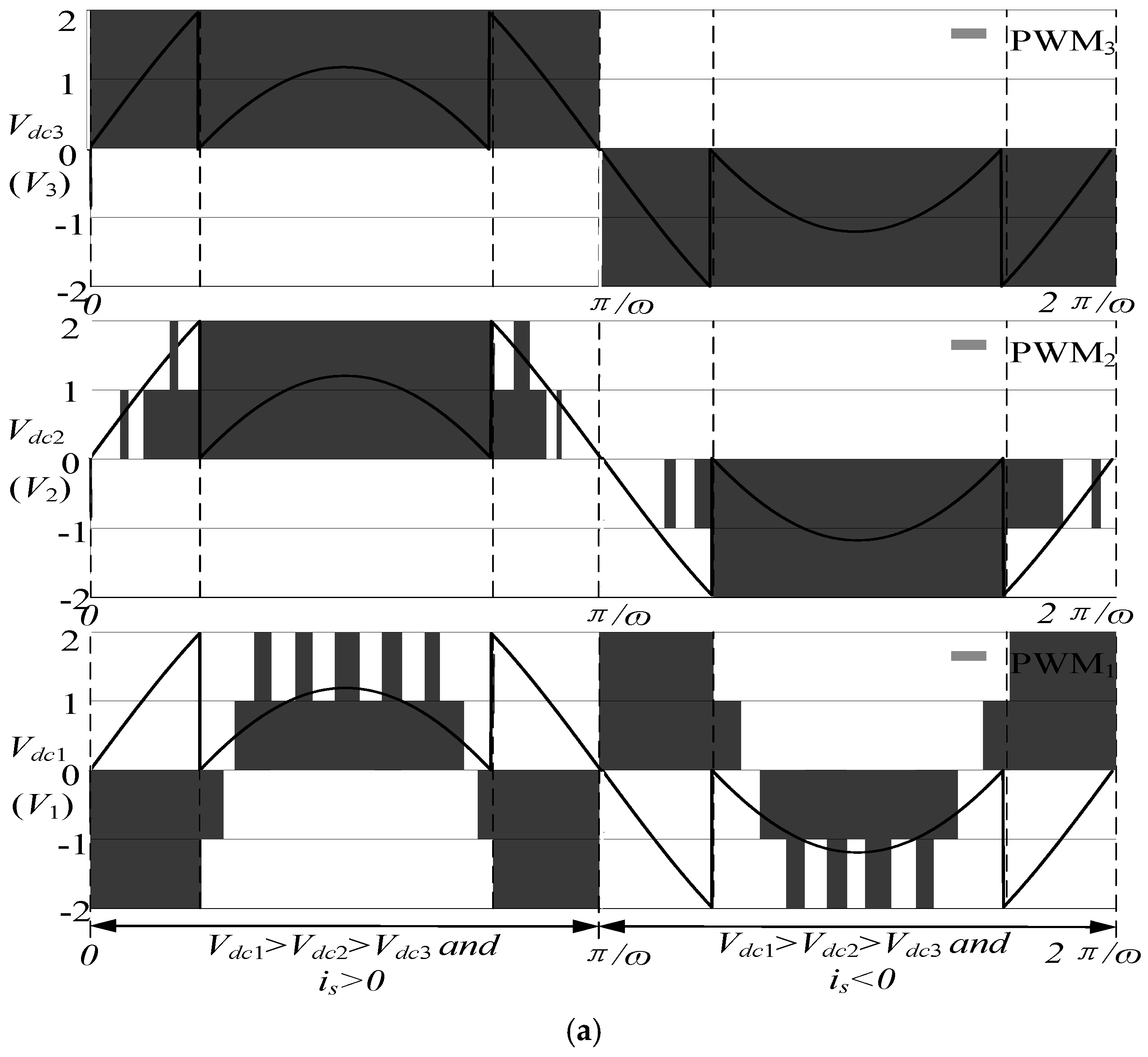
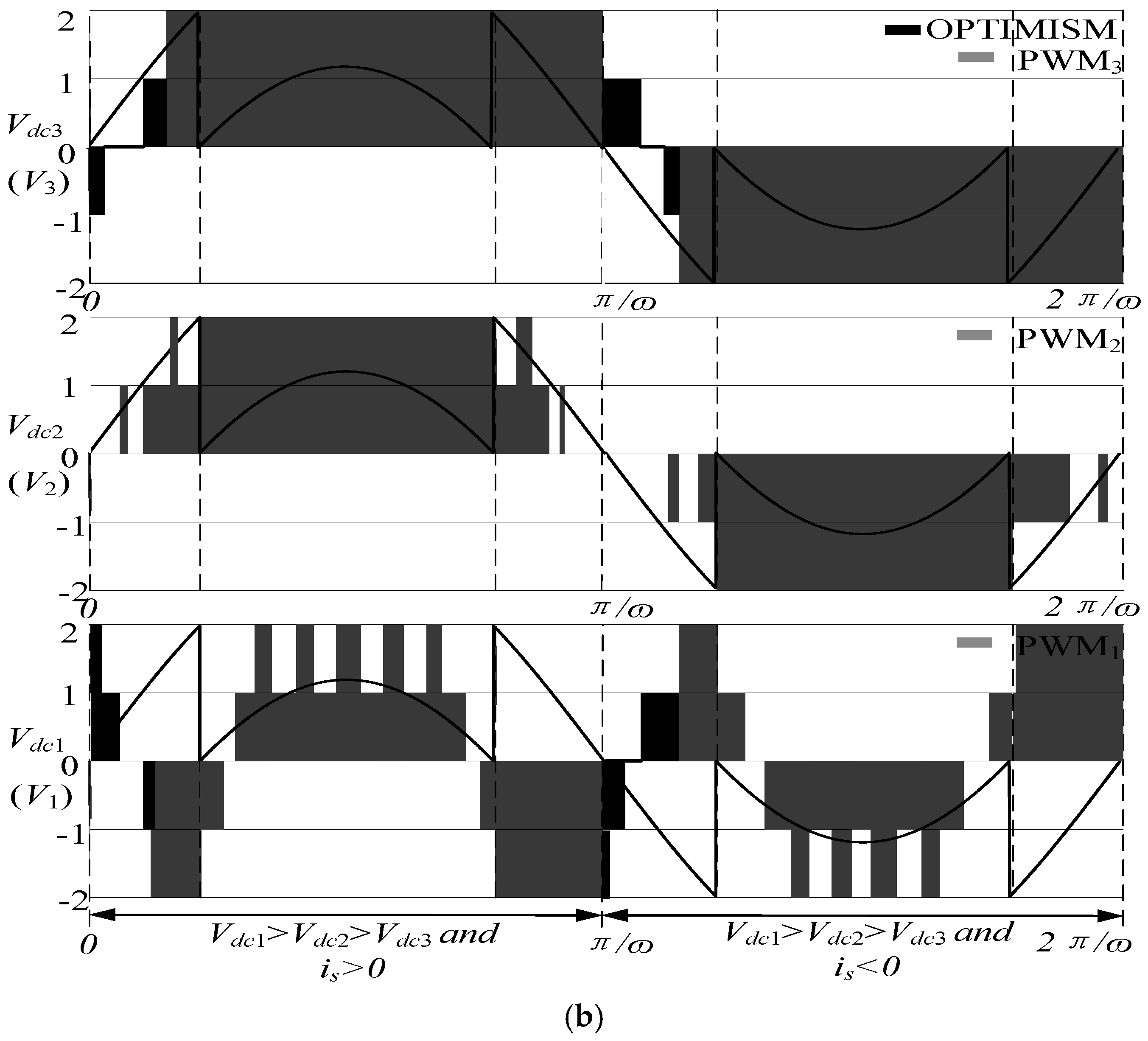
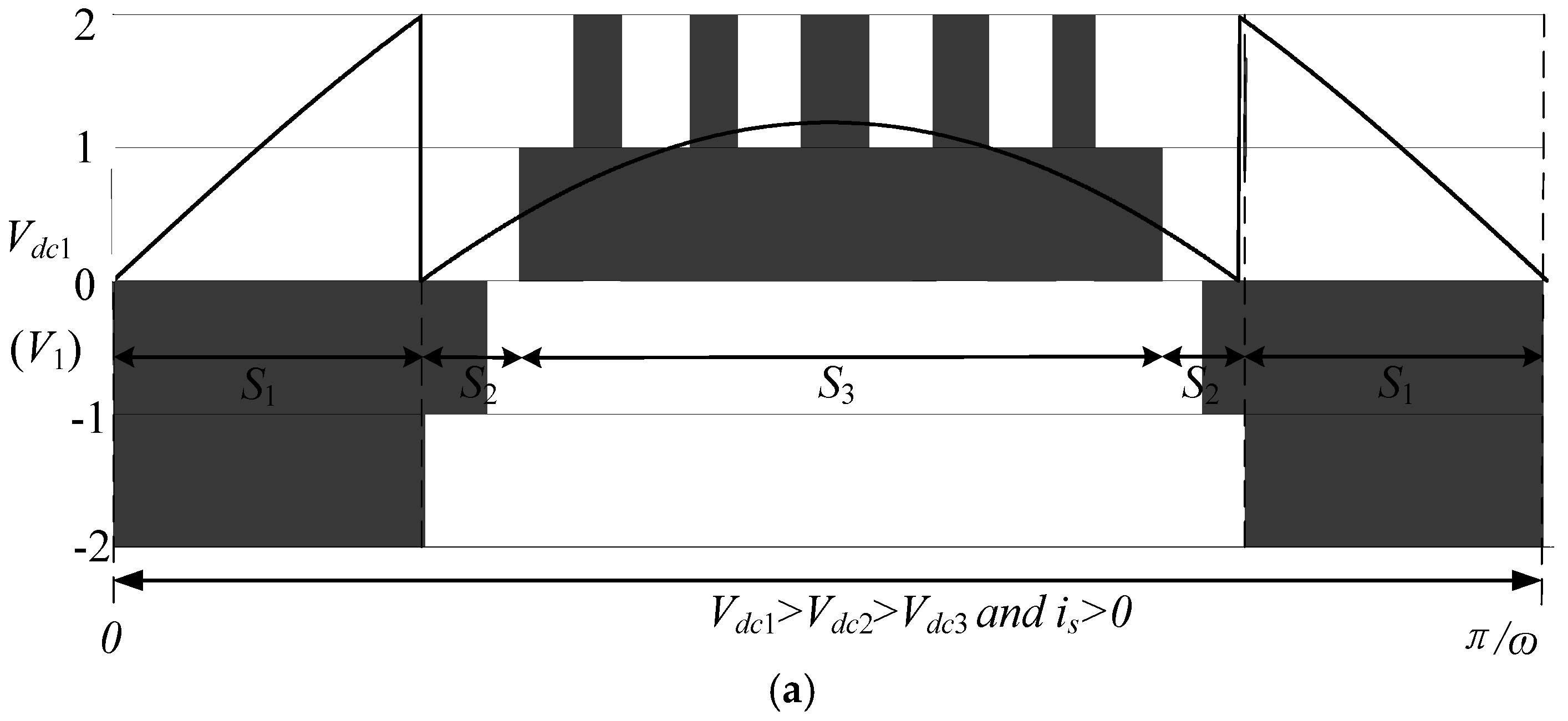
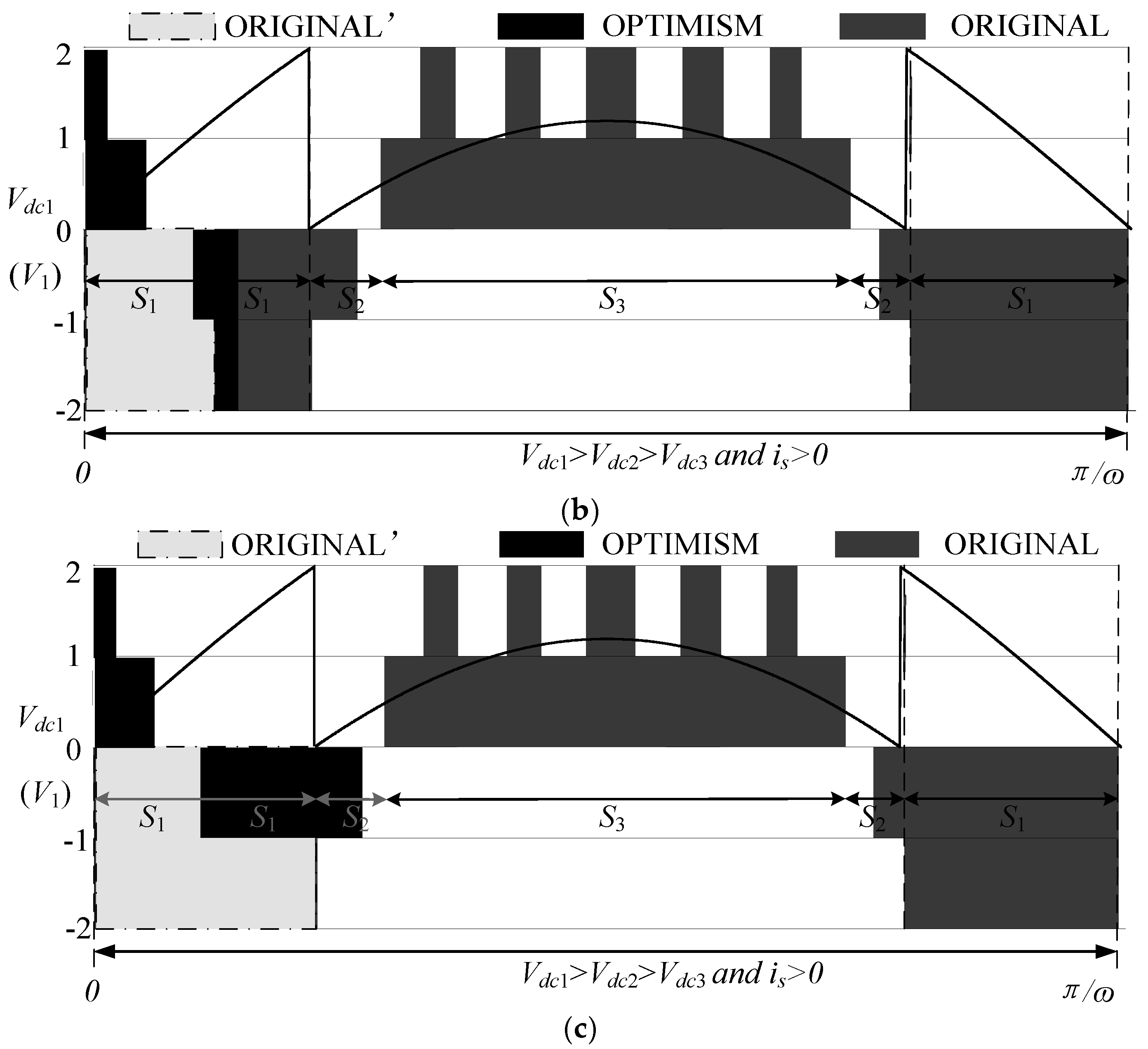




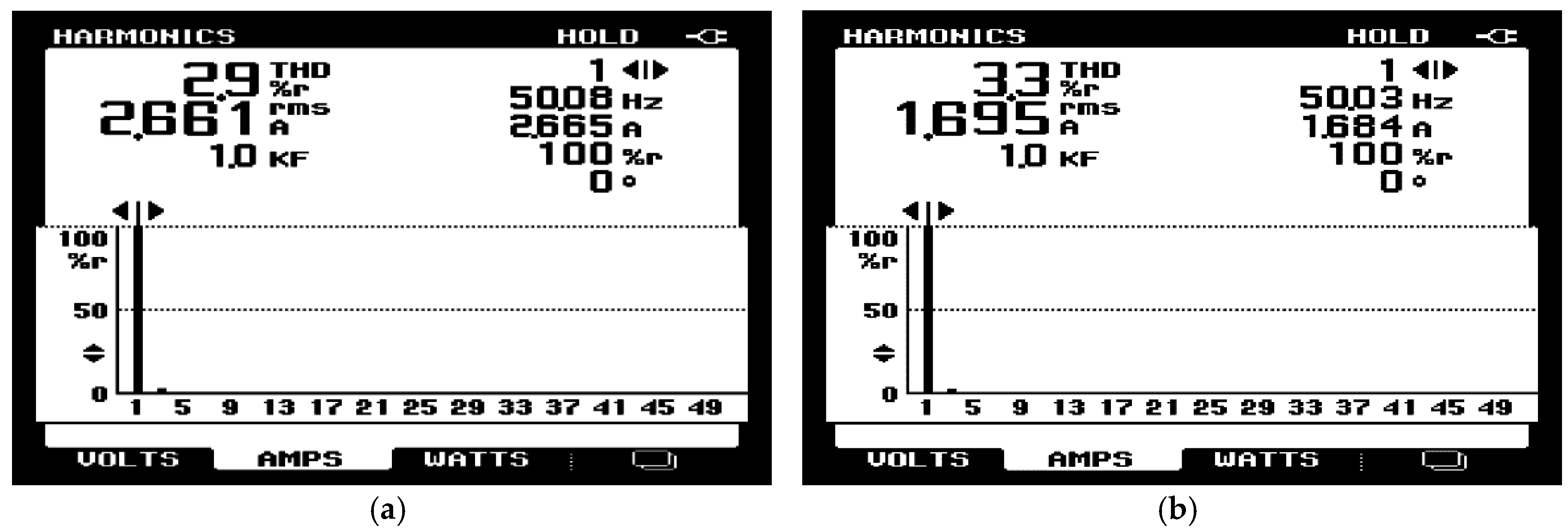
| MODE | is | un | Vc1 | Vc2 | Register |
|---|---|---|---|---|---|
| 00 | >0 | Vc1, 0.5Vdc | charge | no effect | SP |
| <0 | Vc1, 0.5Vdc | discharge | no effect | ||
| 01 | >0 | Vc2, 0.5Vdc | no effect | charge | SP |
| <0 | Vc2, 0.5Vdc | no effect | discharge | ||
| 10 | >0 | −Vc2, −0.5Vdc | no effect | discharge | SN |
| <0 | −Vc2, −0.5Vdc | no effect | charge | ||
| 11 | >0 | −Vc1, −0.5Vdc | discharge | no effect | SN |
| <0 | −Vc1, −0.5Vdc | charge | no effect |
| Case | ||||
|---|---|---|---|---|
| Register sp | sp = 01 | sp = 00 | sp = 00 | sp = 01 |
| Register sn | sn = 11 | sn = 10 | sn = 10 | sn = 11 |
| Case | V1 | … | Vb | Vs | Vs+1 | … | Vn |
|---|---|---|---|---|---|---|---|
| is > 0 | −2 | … | −2 | PWMs | 2 | … | 2 |
| is < 0 | 2 | … | 2 | PWMs | −2 | … | −2 |
| Parameter Name | Parameter Value | Numbers |
|---|---|---|
| Voltage source | 75 V/50 Hz | 1 |
| Filter inductance | 1 mL | 1 |
| DC-link voltage (Vdc) | 38–55 V | 3 |
| DC-link capacitor | 1880 μF | 6 |
| Output power | 114–360 W | 1 |
| Carrier wave frequency | 750 Hz | - |
| Carrier wave frequency | 1500 Hz | |
| Inductance of filter | 1 mL | |
| Capacitance of filter | 2200 μF | |
| Number of modules | 3 |
© 2016 by the authors; licensee MDPI, Basel, Switzerland. This article is an open access article distributed under the terms and conditions of the Creative Commons Attribution (CC-BY) license (http://creativecommons.org/licenses/by/4.0/).
Share and Cite
Peng, X.; He, X.; Han, P.; Guo, A.; Shu, Z.; Gao, S. Smooth Switching Technique for Voltage Balance Management Based on Three-Level Neutral Point Clamped Cascaded Rectifier. Energies 2016, 9, 803. https://doi.org/10.3390/en9100803
Peng X, He X, Han P, Guo A, Shu Z, Gao S. Smooth Switching Technique for Voltage Balance Management Based on Three-Level Neutral Point Clamped Cascaded Rectifier. Energies. 2016; 9(10):803. https://doi.org/10.3390/en9100803
Chicago/Turabian StylePeng, Xu, Xiaoqiong He, Pengcheng Han, Aiping Guo, Zeliang Shu, and Shibin Gao. 2016. "Smooth Switching Technique for Voltage Balance Management Based on Three-Level Neutral Point Clamped Cascaded Rectifier" Energies 9, no. 10: 803. https://doi.org/10.3390/en9100803





